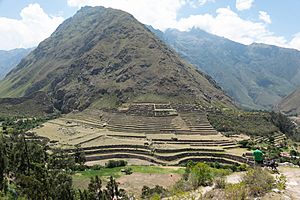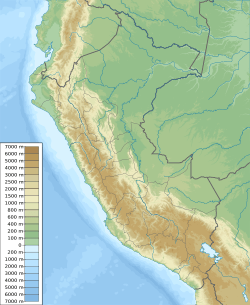Patallacta facts for kids

Patallacta viewed from above on the Inca trail near Willkaraqay
|
|
| Location | Peru, Cusco Region, Urubamba Province, Machupicchu District |
|---|---|
| Region | Andes |
| Coordinates | 13°13′53″S 72°25′53″W / 13.23139°S 72.43139°W |
| Type | Settlement |
| History | |
| Cultures | Inca |
Patallacta (pronounced "pahta-yakta") is an ancient Inca site in Peru. Its name likely comes from the Quechua language, meaning "settlement on a platform." It is also known as Llactapata or Q'ente Marka, which might mean "hummingbird village."
This important historical place is located in the Cusco Region, near the famous Machu Picchu. It sits where the Cusichaca and Vilcanota rivers meet, on a mountain also called Patallacta.
Contents
Discovering Patallacta
When Hiram Bingham was looking for Machu Picchu in 1911, he passed right by Patallacta. Bingham is famous for finding many Inca sites. His friend, Mr. Herman Tucker, noted that the town was called Patallacta. He said it had about 100 houses.
Patallacta is about 1.5 kilometers (about 1 mile) from the start of the famous "Classic Inca Trail." This trail leads to Machu Picchu.
What Was Patallacta Used For?
Patallacta was a busy place in Inca times. It housed many people. This included travelers using the Inca road system. Soldiers also stayed here. They guarded a nearby "hill fort" called Willkaraqay.
The site also had a special religious building. It was called Pulpituyuq. This building had rounded walls. It was used for important religious ceremonies.
Patallacta's Role in History
In 1536, the Inca leader Manco Inca Yupanqui burned Patallacta. He also destroyed other settlements along the Inca road system. He did this to stop the Spanish from following him. Manco Inca was retreating from Cusco at the time.
Because of these actions, the Spanish never found the Inca Trail to Machu Picchu. They also did not discover any of its hidden settlements. This helped keep places like Machu Picchu a secret for many years.
Gallery
See also
 In Spanish: Patallacta para niños
In Spanish: Patallacta para niños






